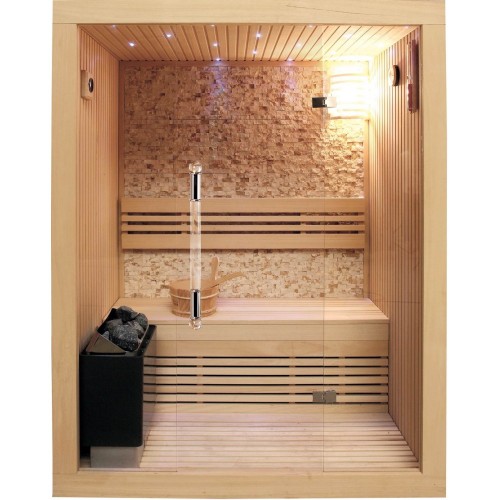Facts About Traditional Sauna Revealed
Facts About Traditional Sauna Revealed
Blog Article
Some Known Questions About Traditional Sauna.
Table of Contents10 Easy Facts About Traditional Sauna DescribedThe Traditional Sauna IdeasRumored Buzz on Traditional SaunaWhat Does Traditional Sauna Mean?
Most of the weight shed in a sauna is water loss and is re-gained upon rehydrating. Without a question sauna can be an essential component of a healthy and balanced weight loss program. To consider the differences in between traditional and IR saunas, I will separate these into proven, academic, and made differences.Hence, the best point in the saunawhich goes to the ceiling straight over the sauna heateris normally in between 185 and 190 F. Traditional Sauna. Claims that a traditional sauna exceeds 200 F is simply not real and not suitable for electric saunas marketed in the United States. The temperature for a far-infrared sauna is usually set between 120 and 140 F; however, unlike the standard sauna, the goal in and IR space is not to accomplish a heat
As a result of this, the temperature distinction is practically unnecessary, considering that excessive sweating leads to both sauna types, yet the technique of heating up the body is different. In an IR sauna the bather will certainly feel hot and will sweat a lot, but at much reduced temperature levels. Thus, if the objective is to spend longer amount of times in the sauna, the IR sauna is an excellent choice.

Examine This Report on Traditional Sauna
When the heat is achieved, the components cycle on and off to maintain the high temperature. A lot of conventional sauna customers appreciate pouring water over the rocks to develop vapor to increase sauna moisture levels. The benefits of pouring water over the rocks include: making the room much more comfortable, moistening the nasal flows, and allowing the use of aromatherapy by blending necessary oils with the water.
In a far-infrared sauna, the warm front pass through the body to efficiently heat the body and increase the body core temperature. To attain this boosted temperature, Far-infrared emitters produce infrared power which is close to the same wavelength as that which the body naturally emitsoften described as the "Crucial Range" of 7 to 14 microns), so the power is well received by the body.
When the energy gets in the body, it triggers the body temperature level to increase and eventually results in sweat. In an infrared sauna it's essential for the emitters/heaters to remain on nearly frequently. Since there is no mass of rocks to keep warm, the sauna will cool down if the emitters shut down.
As pointed out over, the sauna bather in an infrared space wants to place himself in front of operating emitters to obtain optimal take advantage of the heat. The heating time for both areas can be extremely different, depending on exactly how the spaces are made use of. For a typical sauna, a bather ought to enable 30-40 minutes for the room to achieve a desired temperature and to properly pre-heat the rocks.
7 Easy Facts About Traditional Sauna Described
A well constructed sauna will generally achieve a temperature of 150-160 F in about 30-40 minutes (Traditional Sauna). For next hotter temperature levels, the space might require to heat for a longer duration. When the room achieves established temperature level, the heater will certainly cycle on and off, generally operating regarding 50% of the time. The insulated wall surfaces and the warmed rocks will keep the room hot and at stable temperature levels.
To some, 15 mins was "lost" while the infrared power heated the wood panels instead than heating a body, while others locate a pre-heated area to be extra comfy and believe a raised beginning temperature level is necessary to begin sweating. The length of recommended usage for each room is around the get redirected here same (10-15 mins per session); nevertheless, as a result of the lower air temperatures and the ability to feel the impacts of infrared heat much faster than a conventional sauna, it is not uncommon for an individual to spend a total of 20-30 minutes in an infrared sauna.
Conventional saunas often tend to be bigger (therefore use even more electrical energy) than infrared saunas, although traditional saunas are absolutely offered in one and two individual sizes. For a two-person conventional sauna, 5x6 or 5x7 dimension is most preferred. The top bench can comfortably seat 2 or 3 people and is likewise enough time to rest during the sauna session.


The ordinary cost per kWH of electrical power in the united state is about $0.11, so a 4.5 kW heating unit will cost roughly $.50 to run for one hour, if the heating unit runs continuously for one hour. Commonly a sauna heater will certainly run for 75% of the initial hour and 50% of subsequent hours on because the aspects cycle once the set temperature level is achieved.
The Buzz on Traditional Sauna
A 2 person far-infrared room is usually literally smaller sized than a typical sauna, commonly concerning 4' x 4' or smaller sized. The IR heating system is typically like this 1.5-1.7 kW making use of a 120 volt 15 amp plug-in service. Since the area can be utilized faster than a sauna area, we will certainly assume the area is utilized for to of an hour consisting of warmth up time.
Ultimately, there is a hardly ever reviewed difference in the social experience between the 2 spaces. While our culture has actually lost some of the social advantage of the typical sauna experience, it can be very socially fulfilling. From family members time in the sauna, to heart-felt discussions with loved ones, to sauna partiesthe traditional sauna experience can result in intimate mingling.
A lot of higher end infrared spaces include tinted light treatment, noise systems and full-glass fronts.
Report this page